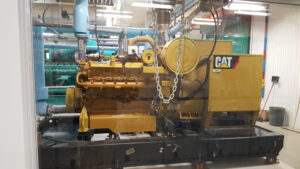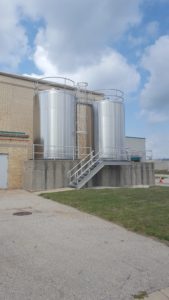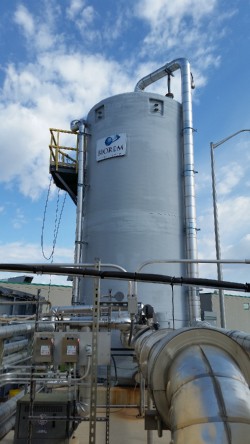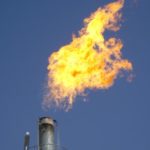Biogas Generator

The engine generator employs a 4‑cycle, 12-cylinder, 1,650 cu in turbocharged engine with a 450 kW, 4,160 V generator manufactured by Caterpillar. The co-generation system is designed to continuously deliver up to 560 kVA of three-phase power. Electrical power will be used within the plant. Switchgear will allow paralleling in the plant with power provided by Alliant Energy. Engine generator heat will be used to heat the anaerobic sludge digester system, the hauled waste storage tanks, and to pre-heat building ventilation air. Any excess heat will be exhausted through radiators in the plant yard area.

We produce biogas through the anaerobic digestion process or fermentation of biodegradable materials such as municipal sludge. In addition to that, we receive high-strength wastes which are hauled in by tanker trucks from local industries that we pump directly into the digesters for increased biogas production. High-strength waste is received and stored in two heated and mixed 304 stainless steel tanks each with a volume of 20,000 gallons prior to pumping to mesophilic digesters.

Through fermentation, biogas is produced. This biogas needs to undergo cleaning before it can be used to prevent damage and corrosion to our biogas engine. Biogas comprises primarily methane and carbon dioxide along with a few other trace gases. We produce approximately 200,000 cubic feet of biogas each day. First, the highly corrosive hydrogen sulfide is removed utilizing a biological system where a controlled environment is maintained inside of a tank for microorganisms to consume the hydrogen sulfide. There are other things that are produced in the digestion process that need to be removed to ensure the beneficial reuse of the biogas. Siloxanes and moisture also need to be removed from the gas.
Click here to view a public service announcement regarding our flare. Video produced by Calie Tasch, Community Risk Reduction Specialist, Fond du Lac Fire & Rescue
Through the practice of flaring, methane is oxidized (through combustion) to carbon dioxide (CO2) and water. From an environmental standpoint, flaring is better than venting since CO2 is 25 times less impactful as a greenhouse gas than methane. 
